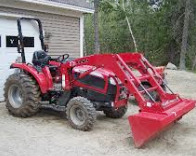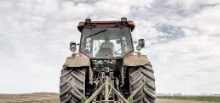________________________________________________________________________________________
| Home / Farm Tractors / Mahindra Tractors / Mahindra 3535 |
Mahindra 3535 Troubleshooting
 The
Mahindra 3535 compact utility tractor was manufactured between 2009 and 2018.
The Mahindra 3535 tractor is powered by Mahindra CE-35 3-cylinder direct
injection water-cooled diesel engine. A 115.4 cubic inches (1.9 L) engine has a
cylinder bore of 3.5" (89 mm), piston stroke of 4.0" (102 mm), and rated power
of 35 hp (26 kW). The Mahindra 3535 is fitted with a two transmission options:
12x12 full synchromesh transmission, or three-range hydrostatic transmission.
The
Mahindra 3535 compact utility tractor was manufactured between 2009 and 2018.
The Mahindra 3535 tractor is powered by Mahindra CE-35 3-cylinder direct
injection water-cooled diesel engine. A 115.4 cubic inches (1.9 L) engine has a
cylinder bore of 3.5" (89 mm), piston stroke of 4.0" (102 mm), and rated power
of 35 hp (26 kW). The Mahindra 3535 is fitted with a two transmission options:
12x12 full synchromesh transmission, or three-range hydrostatic transmission.
The maximum forward speed - 15.3 mph (24.5 km/h), maximum reverse speed - 14.4 mph (23 km/h). The open center hydraulic system includes a gear pump with rated fluid flow of 11 gal/min (41.6 l/min). The main relief pressure is 203 bar (2950 psi). The tractor is equipped with a hydrostatic power steering system, wet disc brakes, 28x8.5-15 front tyres, and 43x16-20 rear tyres. The wheelbase is 71 inches (1800 mm). The tractor is compatible with Mahindra ML120 front end-loader with a maximum lift height of 106" (2690 mm), and Mahindra 485 backhoe with maximum digging depth of 101" (2555 mm).
| Engine Troubleshooting |
| Engine difficult to start or doesn't start |
There is air in the fuel system - Bleed the system.
Clogged fuel filter - Install new filter element.
Fuel injection nozzles are damaged or dirty - Install a new kit of correctly balanced nozzles.
Water in the fuel system - Change fuel and repair fuel system.
The valve clearance is not adjusted - Adjustment procedure required.
Fuel injection pump malfunctioning - Repair or replace injection pump.
| Engine starts but stalls immediately |
Air filter element clogged - Clean or replace the element.
Fuel filter element is dirty - Change the filter element.
Fuel injection pump leakage - Check the fuel injection pump for leaks and fix it.
Dirty or defective injectors - Inspect fuel injectors and change as required.
Fuel injection pump malfunctioning - Repair or install new pump.
| Diesel shuts off while driving |
Coolant temperature is low - Warm up to required temperature.
Fuel filter element clogging - Service the filter.
Air in the fuel system - Air bleeding.
Defective injection nozzle - Install a new kit of correctly balanced nozzles.
Improper fuel injection timing - Set the fuel pump timing correctly.
| Engine stops while idle |
Incorrect low idle setting - Correct low idle settings.
Fuel injection pump is faulty - Install a new pump or rebuild.
Fuel injector fault - Replace fuel injectors.
Excessive valve clearance - Have it adjusted.
| Reduced engine power |
Air filter clogged - Replace air filter element.
Clogged or burnt injection nozzle - Install a new kit of correctly balanced nozzles.
Improper fuel injection pressure - Correct the pressure settings.
The valve clearance is incorrect - Check and adjust as required.
Incorrect low idle speed adjustment - Adjust the low idle speed.
Fuel hoses or lines are clogged - Clean fuel hoses and lines.
Damaged cylinder-head gasket - Install new cylinder head gasket.
Piston rings are worn or damaged - Change piston rings.
| Engine overheating |
Low engine coolant - Top up coolant fluid and check system for leaks.
Engine oil level is insufficient - Check and refill engine oil.
Damaged radiator cap or dirty radiator core - Replace cap or clean radiator.
Fan belt is broken or worn - Replace as required.
Engine overload - Reduce engine load.
| Insufficient oil pressure |
Low crankcase oil level - Add oil to the engine crankcase.
Oil filter element is dirty - Change or clean engine oil filter element.
Oil grade or viscosity is wrong - Drain crankcase and refill with correct oil.
Incorrect oil clearance in main bearing - Bearings need to be reinstalled.
Oil pump is defective - Inspect and change as required.
| Engine noise or knocking |
Engine oil level low - Check and refill engine oil.
Engine not warmed up - Warm up to required temperature.
Improper setting of fuel injection pump timing - Adjust as recommended.
Low idle speed adjustment is incorrect - Adjustment required.
Defective fuel injectors - Inspect fuel injectors and change as required.
Connecting rod is misaligned or defective - Need to align or replace the connecting rod.
Worn or scored pistons - Install new pistons.
| Transmission Troubleshooting |
| Low transmission oil pressure |
Insufficient transmission oil - Add oil to the transmission housing.
Clogged transmission oil filter element (if fitted) - Service or change transmission oil filter.
Stuck relief valve - Change relief valve.
| Transmission makes excessive noise |
Insufficient transmission oil - Check transmission oil level and add oil as required.
Transmission fluid contamination - Change the fluid.
Backlash is incorrect or gears are damaged - Adjust backlash correctly or replace the gears.
Bearings are damaged or worn - Replace faulty bearings.
Worn or bent shift forks - Change the shift forks.
Worn or damaged shaft splines - Replace the shaft.
| Hard to shift gears |
Rusty or worn gear shift linkage - Install a new gear shift linkage.
Damaged or worn gear shift forks - Shift forks need to be changed.
Worn parts of the gear shifting mechanism - Change worn parts.
Worn or improperly adjusted clutch - Adjust or replace the clutch.
| Transmission fluid leaks |
High transmission oil level - Correct the oil level.
Damaged seals or gaskets - Gaskets or seal need to be replaced.
| Hydrostatic Transmission Troubleshooting |
| Excessive HST transmission noise |
Insufficient oil level or contaminated oil - Add oil to proper level or pour fresh transmission oil.
Speed control linkage is worn or unadjusted - Replace or adjust linkage.
Relief valve malfunction - Replace relief valve.
Transmission overloaded - Reduce loading.
Damaged or worn components of hydrostatic transmission - Change or repair defective parts.
| Loss of power |
Transmission oil level is low - Fill the transmission housing with oil.
Relief valve is damaged - Replace valve as required.
Bent or unadjusted speed control pedal linkage - Adjust or change linkage.
| Transmission fluid over heats |
Lack of transmission oil supply - Fill the transmission housing to proper oil level.
Dirty transmission oil filter element - Service or replace the transmission oil filter.
Damaged or clogged cooling components - Check all cooling components and change or repair if required.
Transmission is under excessive load - The load should be reduced.
| External fluid leaks |
Worn seals or gaskets - Install new seal or gaskets.
High internal transmission case pressure - Repair or replace damaged components.
Clogged oil return pipe - Clean or change return pipe.
| Hydraulics Troubleshooting |
| Hydraulic fluid pressure is low |
Low hydraulic oil level - Fill the system to proper hydraulic oil level.
Clogged hydraulic oil filter element - Clean or change hydraulic filter.
Hydraulic pump malfunction - Install a new hydraulic oil pump.
Hydraulic control valve block is out of adjustment - Control valve needs to be adjusted.
Hydraulic cylinder malfunction - Repair or install a new hydraulic cylinder.
Leaking hydraulic lines - Find leaks in the system and fix it.
| Hydraulic system overheats |
Main relief valve is faulty - Relief valve must be changed.
Improper hydraulic oil type - The proper type of hydraulic oil must be used.
Contaminated hydraulic oil - Change hydraulic oil.
Air in hydraulic lines - Bleed hydraulic lines.
| 3-point hitch can't lift or lifts too slowly |
Excessive hitch loading - The load should be reduced.
Low hydraulic fluid level - Add fluid as required.
Clogged hydraulic oil filter element - Service the hydraulic filter or change if required.
Hydraulic pump failure - Change or repair hydraulic fluid pump.
Faulty main relief valve - Change relief valve.
Defective hydraulic control valve block - Repair or replace hydraulic valve.
Defective hydraulic cylinder - Replace or repair hydraulic cylinder.
Suction line is loose or broken - Replace or repair.
| 3-point hitch won't lower or lowers slowly |
Incorrect adjusted hydraulic spool valve - Adjust the spool valve correctly.
Broken hydraulic cylinder - Repair or install a new hydraulic cylinder.
Unadjusted hitch - Adjust as required.
Hitch rock shaft is worn Change the shaft.
| Hitch jerks when drop or lift |
Air in the hydraulic system - Air bleeding.
Hydraulic fluid is dirty - Hydraulic fluid change required.
Defective hydraulic pump - Repair or replace hydraulic fluid pump.
Defective hydraulic spool valve block - Install a new hydraulic valve or repair it.
Hydraulic cylinder is defective - Repair or replace hydraulic cylinder.
| Steering System Troubleshooting |
| Steering wheel is difficult to turn |
Incorrectly fitted or worn steering column - Refit or replace the steering column.
Air lock in hydraulic steering system - Need to bleed air.
Improper toe-in - Check toe-in and correct.
Front tyres wear unevenly - Change the tyres.
Worn steering pump - Repair or replace steering pump.
Stuck or damaged steering pump control valve - Change or flush control valve.
Steering fluid level low - Checking steering fluid level and add it if necessary.
| Excessive steering wheel play |
Worn steering column coupling or shaft - Replace defective part.
Steering pump malfunction - Install a new steering pump.
Worn or loose steering linkage joints - Inspect and replace as required.
| Front wheels wander to left or right |
Front tyres wear unevenly - Change the tyres.
Improper toe-in - Check toe-in and correct.
Steering linkage components are loose or worn - Repair or change steering linkage.
Defective or improperly adjusted front wheel bearings - Adjust properly or replace bearings.
| Electrical Troubleshooting |
| Battery does not charge |
Electrical cable connections are loose or corroded - Clean or tighten connections.
Faulty battery terminal clamps - Replace terminal clamps.
Defective battery - Change the battery.
Defective or loose belt - Adjust belt tension or install a new belt.
| Starter motor cranks slow |
Low battery power - Charge the battery.
Battery drains quickly - Service charging system or install new battery.
Battery terminals are corroded or wires are disconnected - Check wiring and clean or replace terminals.
| Starter doesn't crank |
Battery is discharged or defective - Need to charge or replace the battery.
Wire harness is disconnected or incorrectly connected - Check wire harness and connect as required.
Battery capacity is low - Battery is drained, charge it.
Faulty starter motor - Change or repair starter.
________________________________________________________________________________________
________________________________________________________________________________________
| Farm Tractors Technical Specifications |
